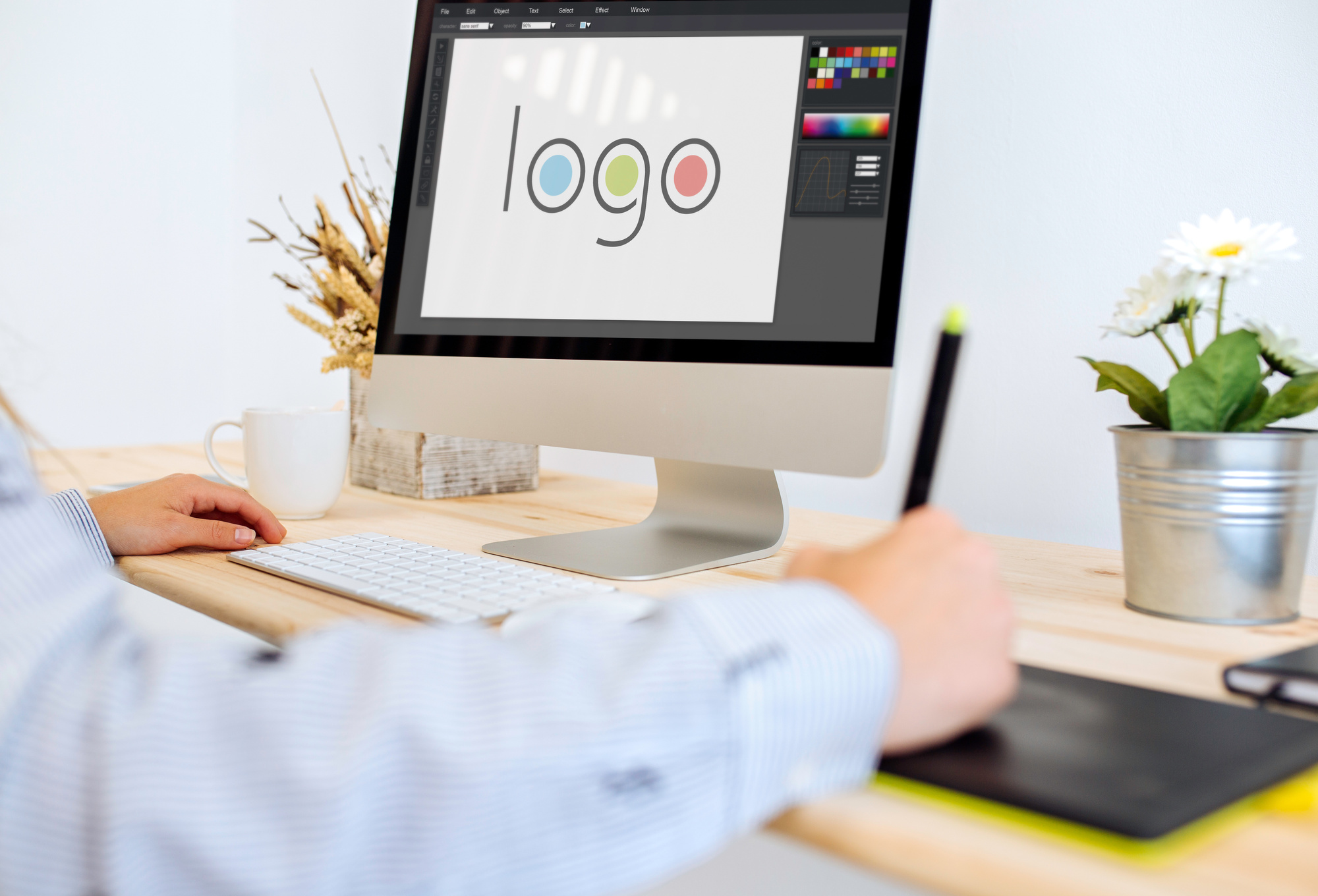7 Hard & Fast Rules of Logo Making
Posted on July 05, 2018 by Logo Design Tips and Tricks

Branding is the best way to get your company noticed. It’s what you could call the summation of your marketing campaign, or even the face your company. What image you choose to project can make or break your business.
One of the biggest aspects of branding is your logo. Your chosen graphic becomes the figurehead for your company and makes your first impression.
Flashy logos project a different brand vision than subdued, text-only logos. It’s up to you what type of logo you want to project to consumers; just ensure it’s unique and representative of your vision.
However, despite the enormous variety in logo making, there are some hard and fast rules that good logos should follow. Deviate from the standard too much and you’ll send customers running in the opposite direction.
To help you get started we’re breaking down 7 rules for logo making that every business should follow. Let’s get started.
Logo Making 101
Logos are more important today than ever to represent your company. The explosion of the internet and web-enabled devices mean we’re becoming more and more visually oriented. U.S. adults spend over 10 hours per day looking at screens, and thus inevitably looking at logos.
Think tech companies for a second. Facebook, Twitter, Instagram, etc. You’re probably picturing either the website itself or its logo. They’re one excellent example of the capitalizing on screen-time with memorable logos.
So it all begs the question, what goes into a successful logo? What do you need to succeed? How do you create a logo as ubiquitous as Facebook’s or Twitter’s?
Well…
Hire a Professional
First and foremost, it’s best to consult a professional. This doesn’t mean you can’t have control over the creative process. In fact, it’s important that you do remain in control over most aspects of your logo.
However, complete control doesn’t mean shutting down suggestions from the people who design logos day in and day out. Professional logo designers know what works and what doesn’t.
Plus, they have the expertise in actually creating your logo. Chances are your staff doesn’t have an in-house graphics professional. Logo design programs like InDesign and Illustrator take years to learn, and even longer to master.
Unique to Your Brand
Though just because you need to find a professional doesn’t mean you can’t start brainstorming in the interim. As we touched on above, keeping your logo unique is priority number one when it comes to initial design.
Think of it this way. You want your logo to remind people about your company. If it’s too similar to another company’s logo, the entire premise is gone before it started.
If you’re selling cars you want people to think of your dealership when they see tour logo. Not your dealership and the one right down the road. You need to capture as much consumer attention as possible.
Balance
So how do you keep your logo unique? Balance makes a good starting point. By balance, we mean keeping the elements of your logo proportional to one another. You don’t want the text to overpower the graphics, and vice versa.
Likewise, you don’t want color to overtake your entire design. Too much color can actually distract from parts of the logo. If someone only sees florescent yellow they might miss the text-based branding.
Scaling
After balance you’ll want to take into account how your logo scales. By scaling, we’re referring to how it looks in small, medium, and large formats. It’s almost certain that you’ll use your logos across different mediums that require different logo sizes.
The key to creating something that scales well is two-fold. First, you need to ensure the logo elements scale. This means text that doesn’t become unreadable and graphics that still look reasonable, small or large.
Second, ensure the logo gets created in the vector file format. Vector graphics use mathematical designs to create your image, and also so don’t distort when scaled.
Typography Matters
We already mentioned text several times above. While we are talking about text (again) we’re focusing this time specifically on the font. The font you choose can make or break your overall design, including your scaling.
Always strike a balance between eye-catching and readable. You want to draw in consumers but also ensure your writing is legible no matter the logo’s size or the consumer’s distance from the logo.
Match Your Brand
You can have a unique, scaling, balanced, logo with high-quality typography but still find it’s worth nothing if the logo doesn’t match your brand. After all, your chosen design needs to represent your brand in the eyes of the consumer.
The way you choose to make this happen is entirely up to your creative team and the professional you’ve hired. Twitter’s logo reminds people they’re “tweeting” with a small bird.
Facebook’s logo consists of just a blue styled “F”. It’s less direct than Twitter, but still invokes the same universal thought, “Oh, that’s Facebook.” Google, on the other hand, takes the most direct approach. Their logo is simply “Google.”
The variance in some of the most prominent logos shows that despite your choice, it’s all about capturing your brand image. Google doesn’t need much of an image, while Twitter keeps it whimsical with their bird.
Keep it Simple
Finally, just keep it simple. People need to think about your company when they see or remember your logo. You want to stay memorable, but not as the brand that has that one cool logo.
Why? While it does sound great that you’re memorable, chances are nearly 100 percent (ok, they’re 100 percent) that your company doesn’t sell logos.
Choosing a Logo Maker
Choosing a professional logo maker means finding someone known for high-quality work who has the time, experience, and resources to make sure your logo fits your vision. Logo making is time-consuming; let a professional do the work while you focus on other parts of your business.
How to Trademark a Logo for Maximum Brand Power
Posted on July 01, 2018 by Logo Design Tips and Tricks

Would you like to know how to trademark a logo?
A logo that you create is central to your brand’s image. It’s also one of the most valuable assets you have in your business.
Think of it this way, what would Nike be worth if it wasn’t instantly recognizable by the swoosh? Well, that mark is worth about $13 billion.
When you trademark a logo, you’re protecting your most valuable asset and you’re setting your company apart from the competition.
Read on to learn what it takes to trademark a logo.
Why Trademark a Logo?
The main advantage that comes with a trademark is the legal protection.
By having an official, federally registered trademark, your company is the only one that can use it. You’re protected under the law.
PayPal has filed suit against music provider Pandora for trademark infringement because they look too similar, according to PayPal.
TRX, the fitness company known for its suspension trainer, successfully won a multi-million dollar judgment against a company that created a knock-off product. It was an infringement of the brand and the product. It has a great product, a strong brand, and a great fitness logo.
This kind of protection would not have been possible if TRX didn’t have the trademark protections in place.
There are some instances where it doesn’t make sense to have a trademark.
It doesn’t make sense to register your logo if you don’t know how long you’ll be in business. You might also decide to change your logo after a few years.
How to Trademark a Logo
The first thing to know about how to trademark a logo is that it’s a long process. It takes a lot of time and it takes about 10 months to go through the trademark process.
State vs. National Trademarks
Depending on your business, you can register the trademark in your state. If you’re a local business with one location and no intention to expand, this might make sense for you. In this case, you’ll want to register your trademark with your state’s secretary of state’s office.
However, if you’re an online business with a national presence, you’ll want to be sure to register your business nationally. That means you’ll have to file with the United States Patent and Trademark Office.
Do Your Research
As you start thinking about whether or not to trademark a logo, start by doing research. You have to ensure that your logo isn’t used by anyone else or it’s not similar to a trademark already in use by another company.
Just about every trademark lawsuit is avoidable with good research.
To research logos and designs, you’ll need to start by visiting the USPTO’s search database.
You need to look at your logo and note all of the design elements that are there and match them with the right code in the USPTO Design Search Code Manual.
You’ll also want to note any keywords, phrases, goods, and services, that your business falls under. You’ll also need to check the international class to make sure that there are no additional conflicts.
There are a few criteria to use when doing your research. Your logo must not:
- Be similar to another logo that’s already in use
- Cannot be offensive or misleading
- Cannot cause confusion in the marketplace
If your logo meets these criteria, then you can proceed.
Use the Logo
If did your research and found that no one is using a logo that’s similar to yours, start to use your logo. This will give you some protection under the law, but you won’t be fully protected.
File the Application
One thing to remember is that you may have a tagline or business name as part of the logo. These must be filed separately, so you’ll have one application for the logo, and another for the business name.
Your application must be complete and meet the USPTO’s strict guidelines. A large percentage of applications that were declined was due to incomplete applications.
You would have to resubmit your application and pay another filing fee.
After you’ve filed your application and it’s been approved, you can then keep an eye out to make sure that no one else is using it or anything that resembles it.
There are trademark watch companies such as CompuMark that specializes in trademark protection. They take the time to do the research so you don’t have to.
Should You File the Application Yourself?
One question you’ll have to answer early on in the process is whether or not you do it yourself, use an online service, or hire an attorney.
There are advantages and disadvantages to each. The main concern for most people who want to trademark a logo is the cost.
At an absolute minimum, it’s $225 for the filing fee for a single class. It also depends on how many classes you want to trademark in and how complex your filing is. You will be responsible for doing the research yourself and filling out the application properly.
On average, online services like Legal Zoom charge about $500. They’ll give you basic research and if there are issues with your application, you’re either on your own or you’ll have to pay more money to have it completed.
An attorney will cost between $1500 – $2000.
Yes, that can be cost prohibitive, but you can increase the likelihood of your application being accepted. It’s been found that attorneys that submit the application are 50% more likely to have them approved than if you do it yourself.
That’s because they will do incredibly thorough research, ensure that the application is complete, and ensure the scope of the trademark isn’t too narrow or too broad.
Your Logo is the Key to Your Success
Your logo is a gateway to connect with your customers. It’s real value, however, gets more powerful over time.
That’s because your customers have had more good experiences with your company, and those positive feelings become associated with your logo.
And that’s also why you want to protect it.
When you know how to trademark a logo, you’re sure to protect your company’s most valuable asset.
If you’d like more great logo tips, check out our blog today.
Winning at Work: Ways to Make a DIY Trophy With Your Company Logo
Posted on June 27, 2018 by Logo Design Tips and Tricks

Fostering fun competitions at work enlivens the spirit of the workplace. It creates an environment where employees have fun and where production is boosted.
To add to the merriment, employers can easily create a DIY trophy at home that’s uniquely outfitted for their business and the contest.
And, no, it won’t look shoddy in the least. At least, not with our tips.
Here, we’ll show you six methods to create the most unique and fun trophies for the workplace from the comfort of your home.
Why Bother?
Friendly contests can increase productivity and feelings of worth in businesses. Supervisors should aim for team contests to avoid any negative feelings that may ensue from competition among individuals. Doing so promotes cooperation and a team spirit, two factors that are integral to a business’s success.
However, silly contests created to instill humor not only make employers more approachable, but they also diffuse any built-up stress from the real stuff. It puts workers at ease and lets them know that laughter needn’t be reserved for their time at home.
Finally, the very act of creating a trophy says more than you can imagine. You took the time to make something for an employee. This demonstrates how much you value them.
Even if you choose to have a trophy custom made through another business, such as Trophies Plus Medals or other popular manufacturers, employees will still feel appreciated.
A Quick Word About Logos
Having your logo taken out into the world on a trophy is an excellent form of marketing. It’s a definite topic for conversation as soon as someone from beyond the company sees it sitting on a mantel or desk.
For DIY projects, consider having a company print your logo on bumper-sticker paper or other material. Not only will you have a quality look and easy application, but the price per sheet is extremely reasonable.
You can also have your logo engraved if you choose to go all-out; after all, it’s an excellent way to ensure it will remain on the trophy forever.
Otherwise, consider using your personal printer to print the logo on sticky matte paper. You’ll be needing it to create every trophy.
Six Ways to Create a DIY Trophy
These methods are convenient for a number of reasons, but mostly because your time is valuable as a manager. Therefore, we’ve selected some of the easiest and quickest ways to create a trophy–without sacrificing its appearance.
1. Disposable Cups and Plates
Chances are you have some plastic cups and plates in the kitchen cupboard somewhere. Rustle them up to create an easy and inexpensive company trophy.
What you’ll need:
- Disposable cups and plates
- Hot glue gun
- Metallic spray paint
- Various toys or items
Create a pedestal or the body of your trophy by placing the cups and plates together however you like. Use your hot glue gun to keep them firmly in place.
Next, place the item you want to be on top and glue it down. Visit your local dollar store for this or take a stroll down the dollar aisle. You’ll be surprised at how many toys you can use as toppers.
Once your soon-to-be trophy dries, take it outside for some spray painting. Metallic colors and paint/primer combinations are the best and easiest way to give the product a finished, authentic look.
Slap on your logo and consider it a job well done.
2. Kitchenware
If you’d like to be super authentic, you can always purchase real glassware to use as a trophy, but be sure to notify your winners!
Use the same method as above, but be sure to substitute the glue and spray paint for glass-appropriate adhesive and paint.
3. Cans and Candlesticks
Hit up your local Goodwill or thrift store for some likely-looking candlesticks, and save those tin cans.
What you’ll need:
- Candlestick
- Tin can
- Glue gun
- E-6000 glue
- Primer
- Metallic spray paint
Glue the tin can to the candlestick. If you have any other trinkets you would like to add to the trophy, glue them on.
Apply primer to the trophy, then the spray paint. Add on your label and your trophy is finished. Simple and easy.
4. Wooden Objects
Find any wooden objects that could be used for a trophy’s base. Watch them transform.
What you’ll need:
- Wooden object, preferably rectangular
- Stick-on felt
- Wood glue
- Spray lacquer
- Epoxy
- Masking tape
- Any items for the top
- Stickers or adhesive nameplates
Apply spray lacquer to the wood if you would like to give it a glossy finish. Let it dry.
Using the base of the wooden stand, cut a piece of felt to apply to the bottom of the stand.
Saw the top of the wooden stand to bare wood, then mask off the rest of the wood. Spray the lacquer onto the top.
After it dries, add whatever item you desire to the top and set it with epoxy glue. Add your logo and any other nameplates you would like, and you’ll have a beautiful trophy.
5. Plastic Bottles
Do you like recycling? If so, you may be surprised to learn you can turn those old plastic bottles into a killer trophy.
What you’ll need:
- A plastic bottle
- A nail
- Pipe cleaners
- Low-temperature glue gun
- Spray paint
- Scissors
- Matboard
Cut the bottom of the plastic bottle off. Using a nail, insert two holes near the cut portion of the larger piece. Twist your pipe cleaners to look like the handles of the trophy. Have one portion twisted to insert into the hole, which will keep the handles in place.
Add both handles.
Cut out a circular piece of matboard to fit the original bottom of the plastic bottle. Adhere it to the opening of the piece. After it dries, glue the curved end of the original bottom to the mouth to create a base. Apply spray paint and any labels.
Recycling and rewarding; that’s what business is all about.
6. Plaques
When we think of “trophies,” we forget about the fancy plaques that are handed out for many awards. However, these are a type of trophy, too, and they’re a classy way to get your logo out there.
What you’ll need:
- Flat or beveled finished wood
- Sponge brush
- A photo and your logo
- Mod Podge
Print off the image you would like to be on the plaque. Apply Mod Podge to the back of the print-off and center it on the wood.
After it dries, apply the Mod Podge to the top of the entire thing, including your image. It will secure the photo in place.
Create Your Logo and Images
Not only is a DIY trophy fun to make, but these six methods are easy ways to show your employees you care.
If you’re ready to transform your logo or take things up a notch for your trophies, we’re here to help. Use our online logo maker to add some pizazz to your logo or dream up new ideas.
After all, what’s work without a little fun?
9 Fashion Logo Meanings Exposed
Posted on June 27, 2018 by Logo Design Tips and Tricks

Have you ever looked at your favorite clothing store and wondered, ‘what does this fashion logo even mean?’. Well, during this article we’re going to expose the stories behind nine of these fashion house logos.
That way you can know with confidence the background of the logo you’re proudly displaying on your clothes.
They say it only takes customers ten seconds to judge a brand’s logo. However, we can only assume this applies when the consumers aren’t in possession of the full facts. We wonder whether it’ll still take you ten secs to form an opinion after hearing what we have to say.
So, with that in mind, let’s dive on in!
1.) Versace
As some of you may already know, the scary looking woman in Versace’s logo is Medusa. On the face of things, this seems like an odd choice.
However, it’s her transformation from something horrific into the goddess Athena that inspired Gianni Versace’s logo. This was a shrewd move on his part because it evoked a sense of fascination with the brand, as well as an air of authority.
It’s believed that Donatella Versace said that the logo came to be because whoever falls in love with Medusa, can’t go back! Hence, suggesting that the brand would have the same effect on its customers.
This notion’s kinda creepy, but intriguing at the same time. A clever bit of branding if ever there was one!
2.) Chanel
One of the myths behind Chanel’s logo is that it represents the relationship Chanel had with a man called Boy Capel. Rumour has it; he was the love of Chanel’s life, and he funded her first ever boutiques.
However, there was never a formal business contract made between the two of them that bound them together. Likewise, no marriage certificate ever solidified their relationship.
Hence, the double C logo is supposed to reflect the fact that Chanel and Capel spent their lives overlapping but never fully facing one another- which is why the C’s are positioned back to back.
3.) Rolex
We love this one.
Rolex’s logo is an extension of their slogan; “A Crown for Every Achievement.”
What a lovely tribute to self-confidence, self-motivation, and perfectionism. Naturally, these three characteristics are things most of us strive for!
4.) Alexander McQueen
Now, this logo may seem deceptively simple. However, by placing the ‘c’ inside the ‘Q,’ they’re hinting at the potential for the brand to grow. Hence foreshadowing the powerhouse this fashion brand’s become.
5.) Hollister
For those of you who don’t already know, Hollister’s brand’s based on a character called John M. Hollister. However, this guy is entirely fictional!
This boy was said to of spent his days surfing and chilling at the beach. So, as an adult, he opened a store in California and named it after himself.
This was a smart piece of marketing because this fictitious story generated interest and made the brand stand out from its competitors.
6.) Nike
The Nike “Swoosh” is internationally recognized and donned by thousands of Nike fans across the world.
This logo was designed by Carolyn Davidson, a graphic design student studying at Portland State University. It’s rumored that the founder of Nike, Phil Knight didn’t particularly like any of the designs Davidson came up with.
However, as they were running out of time he selected the “Swoosh” and said; “I don’t love it, but it will grow on me.”
Little did he know that this logo would eventually achieve global recognition!
At the time, Caryln earned $35 for her original designs back in the early 70’s. However, she later received considerable stock options in the company once the business took off.
7.) Superdry
Have you ever wondered what the Japanese characters mean on their logo?
Well apparently, they say: “kyokudo kanso (shinasai),” When translated, this says ‘maximum dry,’ followed by the word ‘do’ placed in brackets.
From this, we can assume this is a weak attempt at writing ‘Do Superdry’ in Japanese.
It’s funny to think of corporate geniuses crowding over a Japnese to English dictionary trying to work it out for themselves, without hiring a consultant with real knowledge of the language!
8.) Air Jordan III
Did you know the logo used for these shoes was taken from a still photograph,? Jordan wasn’t even dunking!
He was standing and jumping with his legs apart. There was no running and taking off involved. Instead, it was a glorified ballet move with a basketball!
Needless to say, however, they managed it. The logo looks fantastic! It’s just funny to think of how this logo was staged.
9.) Lacoste
You might know this already, but the Lacoste alligator came to be because of the tennis player, Ren? Lacoste. He was the world’s number one player between 1926 and 1927 and was nicknamed “The Alligator” by the press.
He got this tag because Lacoste had a bet going with the French Davis Cup captain involving an alligator skin suitcase.
However, when he came back to France, the alligator became a crocodile, and the tennis star became famously known as “the Crocodile.”
This triggered a friend of his to draw a crocodile for him, of which he embroidered on a blazer. Then he wore on the tennis court to make a statement!
Has This Article Changed Your Opinion of Your Favorite Fashion Logo?
We hope you enjoyed this article. If any of these backstories inspired you to create your own fashion logo, please feel free to check out our blog, for a few handy hints and tips on the topic.
Over there we discuss everything from creating a logo when you’re on a budget to executing logo redesign. Enjoy!








